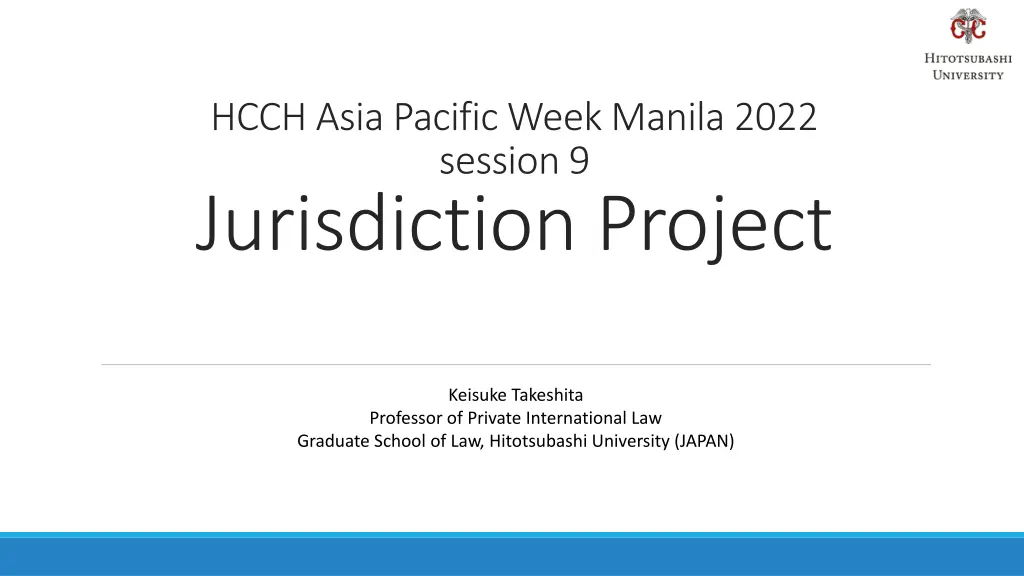
Jurisdiction Project at HCCH Asia Pacific Week Manila 2022
Explore the history, core issues, objectives, and current discussions of the Jurisdiction Project led by Keisuke Takeshita at the HCCH Asia Pacific Week Manila 2022. Learn about the benefits, ongoing developments, and the importance of global judicial cooperation in the realm of private international law.
Download Presentation

Please find below an Image/Link to download the presentation.
The content on the website is provided AS IS for your information and personal use only. It may not be sold, licensed, or shared on other websites without obtaining consent from the author. If you encounter any issues during the download, it is possible that the publisher has removed the file from their server.
You are allowed to download the files provided on this website for personal or commercial use, subject to the condition that they are used lawfully. All files are the property of their respective owners.
The content on the website is provided AS IS for your information and personal use only. It may not be sold, licensed, or shared on other websites without obtaining consent from the author.
E N D
Presentation Transcript
HCCH Asia Pacific Week Manila 2022 session 9 Jurisdiction Project Keisuke Takeshita Professor of Private International Law Graduate School of Law, Hitotsubashi University (JAPAN)
History of the Project Core Issues of the Project Objectives and Benefits Introduction Current Discussion in the WG Concluding Remarks
1. History of the Project 5th Meeting of EG 2nd Meeting of WG 1st Meeting of EG 3rd Meeting of EG 2012 2013 2019 2020 2021 2022 22nd 2nd Meeting of EG 1st Meeting of WG 3rd Meeting of WG 4th Meeting of EG Diplomatic Session CGAP 2022 CGAP 2020 CGAP 2021 CGAP 2019
2. Core Issues of the Project Remaining issues that are not dealt with in 2005 Choice of Court Convention and 2019 Judgments Convention Related Actions or Claims Jurisdiction Jurisdiction Parallel Proceedings Related Actions or Claims Flexible Mechanism for Communication among courts Parallel Proceedings Flexible Mechanism for Communication
3. Objectives and Benefits Access to justice for all in transnational civil or commercial litigation Adjudication of disputes in an appropriate forum Benefits of new instrument[s] Providing greater predictability and certainty Reducing costs for the dispute resolution Avoiding the risks of the inconsistent judgments
4. Current Discussion in the WG Discussion on rules for parallel proceedings [T]he primary role of both jurisdictional rules and the doctrine of forum non conveniens (Para. 9 (b) of Conclusion & Recommendation of 2021 CGAP) The basic structure of rules described in the flowchart Using certain connections to Contracting States (grounds of jurisdiction) Determining the more appropriate forum in consideration of various factors (based on FNC criteria) in cases where s where more than one court has a connection under the possible future Convention Giving priority to the court first seised when the courts of parallel proceedings do not reach the same decision on the appropriate forum Annex II of Annex I to the Report of the Working Group on Jurisdiction Prel. Doc. No 7 of February 2022 (2022 CGAP)
The Age of Global Cooperation Difference of the current social environment from that in early 1900s when Japan tried to participate in HCCH Global judicial cooperation based on mutual trust 5. Concluding Remarks New Instrument[s] for the Future World Instrument[s] not only for our generation but also for the future generations Constructive flexibility in the discussion Necessity of new ideas based on creative imagination
Thank you for your attention Keisuke Takeshita Professor of Private International Law Graduate School of Law, Hitotsubashi University (JAPAN) kei. akeshita r.hit-u.ac.jp
